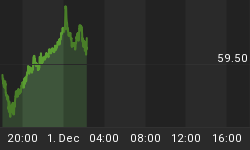Watch the Elections US Payrolls and French Elections
We mentioned in Thursday morning's note that: "a strong services ISM from the US including a favorable employment index is expected to trigger renewed euro selling towards 1.3570, a break of which could extend to 1.3545-50". Indeed, EURUSD fell from 1.36 to 1.3570 and is now trading at 1.3548, with the low being 1.3547. This point represents the 38% retracement of the $1.3339-1.3680 move. But we do expect the pair to stabilize back towards the 1.3580s by Friday European trade ahead of US payrolls.
Yet the principal source of euro weakness could come from Sunday's French presidential election in the event that socialist candidate Segolene Royal wins over Rightist candidate Nicolas Sarkozy. A combination of an upside surprise in US payrolls on Friday followed by a Royal Victory could drive the euro towards the $1.34 figure, especially if markets reduce the odds of a Fed easing later this year.
Almost exactly two years to the month after France rejected a referendum on European Union Constitution-dealing a severe blow to the euro -- France's decision on its next president may have an impact on the single currency.
Mr. Sarkozy served as Interior and Finance Minister in the outgoing rightist government and won the first round of elections with 31.2% over Royal's 25.9%. Mr. Sarkozy is seen as an advocate of free markets, vowing to cut taxes, create more labor market flexibility and reduce the role of State intervention in private companies. He also favors abolishing the 35-hour week brought about by the last Socialist government and intends to increase the number of hours to improve personal incomes and overall growth.
Ms. Royal's socialist-oriented agenda favors state intervention in many industries such as defense, aerospace and energy companies, while raising pension funds partially funded with taxes on stock market revenue. A victory by her would not only be a surprise (since she is trailing behind with 5-6 percentage points in opinion polls), but also weigh on the euro due to her social-friendly policies.
Both candidates have openly spoken in favor of weakening the euro and taking greater political control from the European Central Bank. Even the market-friendly Sarkozy complained about the strength of the euro, which he said strained French exports further widened the nation's trade deficit. But with Segolene Royal's policies seen in favor of higher taxes and more State interventionism, the surprise effect of her victory would not only remove the center right incumbent government but also trigger a negative euro reaction.
Last night's presidential debate between Royal and Sarkozy was deemed a draw by most political analysts, but an Internet poll showed 53% of the 900 people polled to have found Mr. Sarkozy more convincing than Ms. Royal's 31%. But it is notable that centrist candidate Francois Bayrou (who came placed 3 rd in the first election round and whose electpriare could trigger the 18% swing vote) said he would not vote for Mr. Sarkozy based on his performance in last night's Televised debate.

Still Bearish on Aussie
Once again, we are issuing a note highlighting our bearish expectations for the Australian dollar. The last note we sent out was in April 23, suggesting AUDUSD would be dragged down to 0.8225 from 0.8280. Indeed, the pair dropped to 0.8225 before pushing back higher. We expect the pair to find renewed downside on a combination of a falling hawkishness in tonight's quarterly monetary policy statement by the Reserve Bank of Australia, and upside data surprise from the US. There will be sufficient time between the 9.30 pm EST release of the RBA statement and the 8.30 am EST release of the US payrolls report. Thus we see the prospects for AUDUSD, testing the 0.82 figure, and subsequent target at 0.8180. In the event that payrolls come in neutral (between 95 and 110K), we expect renewed downside pressure on the Aussie. Any number above 110-120K should be AUD negative. A payrolls figure below 90K can potentially lift the pair back up 0.8250 and 0.8290, especially in case the US unemployment rate rises to 4.5%.

We're also still bearish AUDCAD, as the Canadian dollar continues its stellar performance, soaring to 7-month highs against the US dollar and 6-month highs against the euro. Pitting the strong CAD against the weak AUD is a strategy that continues to pay. The pair has dropped for a 13 consecutive days, losing nearly 9% in less than 3 weeks. On April 23, we issued a bearish note to clients from 0.9335, calling for a 0.9225 target. Today, the pair trades at 0.9118. We expect further declines towards 0.9050, followed by 0.8980. There RBA has left interest rates unchanged at 6.25% after Q1 CPI slowed to 2.4% y/y, while the RBA's preferred target fell to 2.7%, within the RBA's preferred target of 2-3%.
















